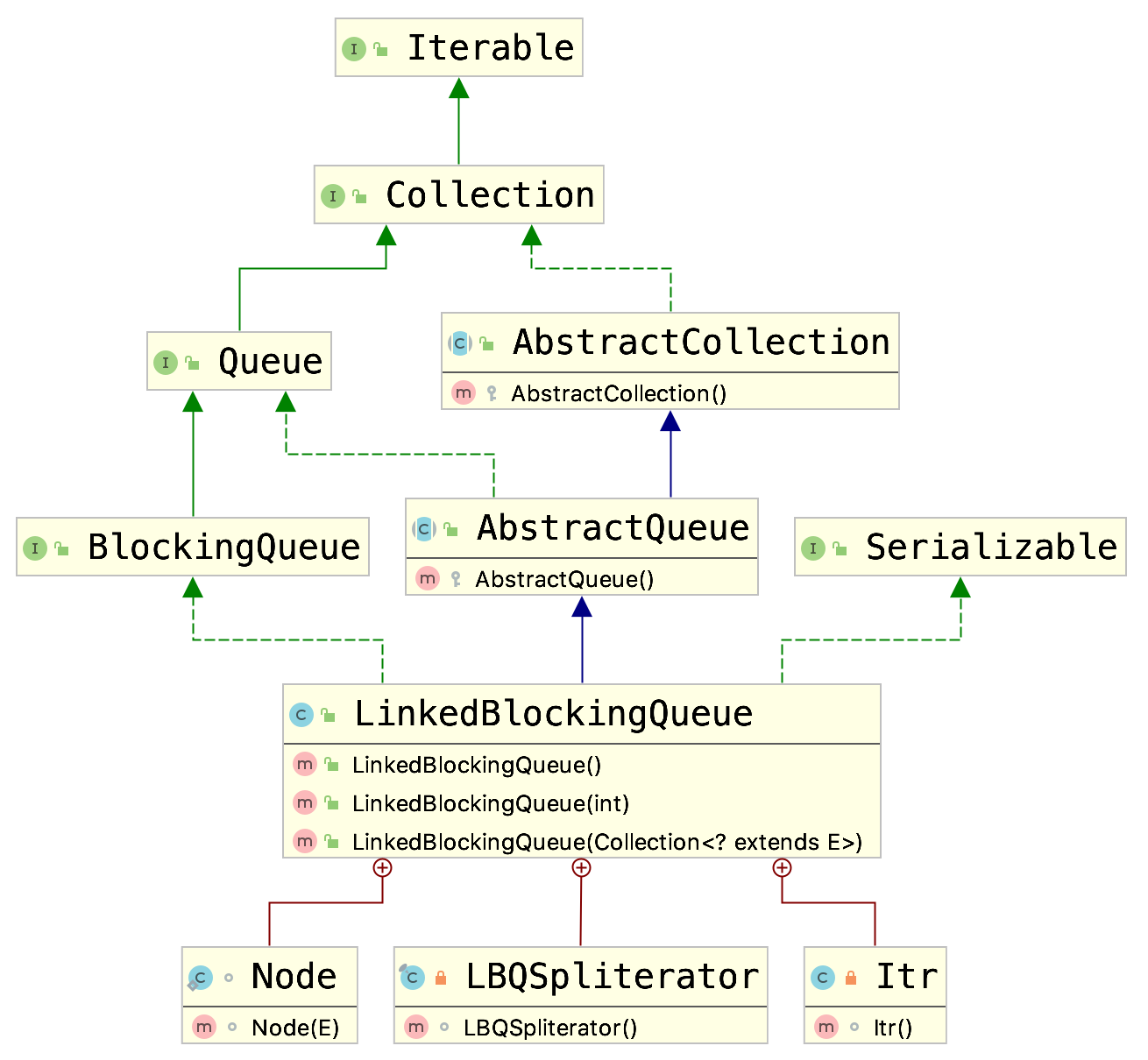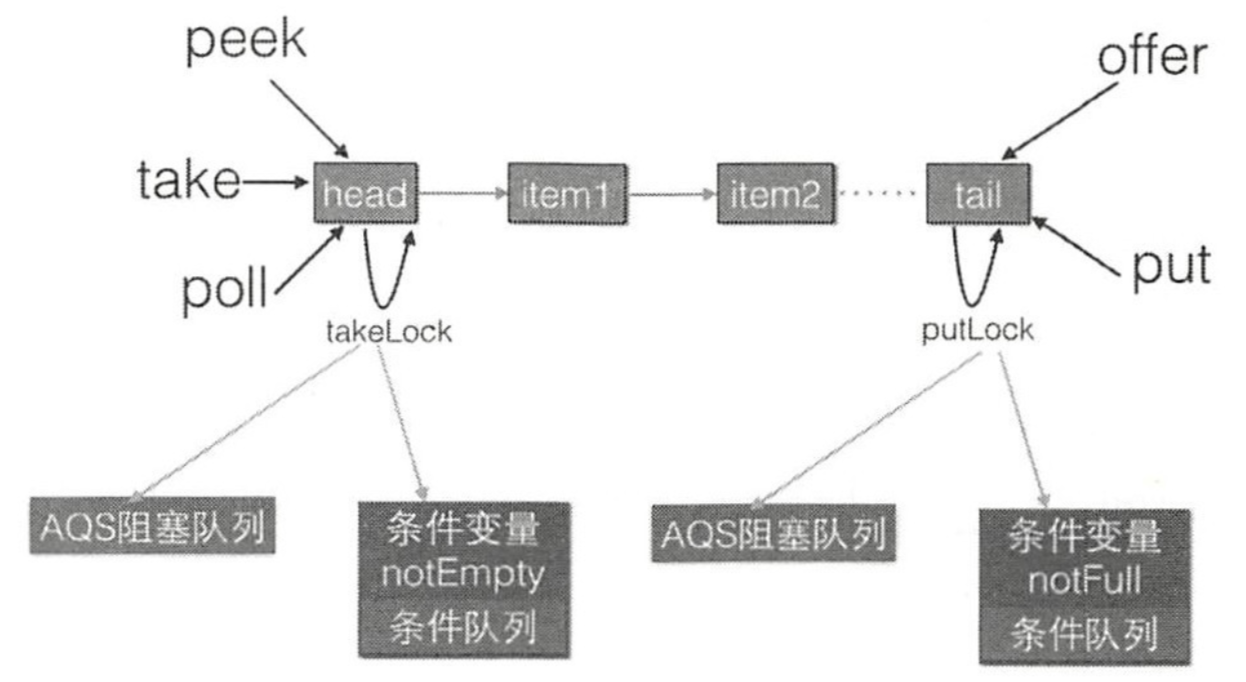java并发:阻塞队列之LinkedBlockingQueue
初识LinkedBlockingQueue
LinkedBlockingQueue是线程安全的有界阻塞队列,其底层使用单向链表实现。
其类图如下:

其构造函数如下:
/** * Creates a {@code LinkedBlockingQueue} with a capacity of * {@link Integer#MAX_VALUE}. */ public LinkedBlockingQueue() { this(Integer.MAX_VALUE); } /** * Creates a {@code LinkedBlockingQueue} with the given (fixed) capacity. * * @param capacity the capacity of this queue * @throws IllegalArgumentException if {@code capacity} is not greater * than zero */ public LinkedBlockingQueue(int capacity) { if (capacity <= 0) throw new IllegalArgumentException(); this.capacity = capacity; last = head = new Node<E>(null); } /** * Creates a {@code LinkedBlockingQueue} with a capacity of * {@link Integer#MAX_VALUE}, initially containing the elements of the * given collection, * added in traversal order of the collection's iterator. * * @param c the collection of elements to initially contain * @throws NullPointerException if the specified collection or any * of its elements are null */ public LinkedBlockingQueue(Collection<? extends E> c) { this(Integer.MAX_VALUE); final ReentrantLock putLock = this.putLock; putLock.lock(); // Never contended, but necessary for visibility try { int n = 0; for (E e : c) { if (e == null) throw new NullPointerException(); if (n == capacity) throw new IllegalStateException("Queue full"); enqueue(new Node<E>(e)); ++n; } count.set(n); } finally { putLock.unlock(); } }
解读:
LinkedBlockingQueue维护有两个 Node 节点分别用来存放队列的首、尾节点。
创建队列时头、尾节点指向一个 item 为 null 的哨兵节点。
Node的定义如下:
/** * Linked list node class. */ static class Node<E> { E item; /** * One of: * - the real successor Node * - this Node, meaning the successor is head.next * - null, meaning there is no successor (this is the last node) */ Node<E> next; Node(E x) { item = x; } }
Note:
构造LinkedBlockingQueue对象时如果没有指定其容量大小,则默认容量类似无限大小(Integer.Max_VALUE);此情况下,如果生产者的速度大于消费者的速度,则可能在队列尚未阻塞生产者时系统的内存已经被消耗殆尽了。
LinkedBlockingQueue之所以能够高效的处理数据,是因为其对生产者端和消费者端分别采用了独立的锁来控制数据同步;这意味着在高并发场景下,生产者和消费者可以并行地操作队列中的数据。
关于锁的定义如下:
/** Lock held by take, poll, etc */ private final ReentrantLock takeLock = new ReentrantLock(); /** Wait queue for waiting takes */ private final Condition notEmpty = takeLock.newCondition(); /** Lock held by put, offer, etc */ private final ReentrantLock putLock = new ReentrantLock(); /** Wait queue for waiting puts */ private final Condition notFull = putLock.newCondition();
解读:
对头 、 尾节点的独占锁都配备了一个条件队列,用来存放被阻塞的线程。
下面来查看LinkedBlockingQueue中比较重要的几个方法:
添加元素
offer方法的代码如下:
/** * Inserts the specified element at the tail of this queue if it is * possible to do so immediately without exceeding the queue's capacity, * returning {@code true} upon success and {@code false} if this queue * is full. * When using a capacity-restricted queue, this method is generally * preferable to method {@link BlockingQueue#add add}, which can fail to * insert an element only by throwing an exception. * * @throws NullPointerException if the specified element is null */ public boolean offer(E e) { if (e == null) throw new NullPointerException(); final AtomicInteger count = this.count; if (count.get() == capacity) return false; final int c; final Node<E> node = new Node<E>(e); final ReentrantLock putLock = this.putLock; putLock.lock(); try { if (count.get() == capacity) return false; enqueue(node); c = count.getAndIncrement(); if (c + 1 < capacity) notFull.signal(); } finally { putLock.unlock(); } if (c == 0) signalNotEmpty(); return true; }
解读:
如果待插入元素 e为 null,则抛出 NullPointerException异常。
如果队列中有空闲,则插入成功后返回 true;如果队列己满,则返回 false。
从代码可知offer方法通过使用 putLock锁保证了在队尾新增元素操作的原子性。
Note:
该方法是非阻塞的。
该方法在元素入队成功后,将唤醒 notFull 的条件队列里面被阻塞的一个线程(如:执行 put 方法时,因队列满了而被阻塞的线程),因为队列现在有空闲所以这里可以提前唤醒一个生产者线程。
put方法代码如下:
/** * Inserts the specified element at the tail of this queue, waiting if * necessary for space to become available. * * @throws InterruptedException {@inheritDoc} * @throws NullPointerException {@inheritDoc} */ public void put(E e) throws InterruptedException { if (e == null) throw new NullPointerException(); final int c; final Node<E> node = new Node<E>(e); final ReentrantLock putLock = this.putLock; final AtomicInteger count = this.count; putLock.lockInterruptibly(); try { /* * Note that count is used in wait guard even though it is * not protected by lock. This works because count can * only decrease at this point (all other puts are shut * out by lock), and we (or some other waiting put) are * signalled if it ever changes from capacity. Similarly * for all other uses of count in other wait guards. */ while (count.get() == capacity) { notFull.await(); } enqueue(node); c = count.getAndIncrement(); if (c + 1 < capacity) notFull.signal(); } finally { putLock.unlock(); } if (c == 0) signalNotEmpty(); }
解读:
如果待插入元素 e为 null,则抛出 NullPointerException异常。
如果队列中有空闲,则插入成功后返回 true;如果队列己满,则阻塞当前线程(调用 notFull 的 await()方法把当前线程放入 notFull 的条件队列,并释放putLock锁),直到队列有空闲后插入成功后再返回。
问题:上述代码在判断队列是否为空时为何使用 while 循环而不是 if语句?
这是考虑到虚假唤醒的情况,notFull.await()在其他线程没有调用 notFull 的 singal 方法时也可能返回。
如果使用 if语句,那么虚假唤醒后会执行元素入队操作,并且递增计数器;由于队列己经满,将导致队列元素个数大于设置的容量,进而导致程序出错。
使用 while循环时,如果 notFull.await()被虚假唤醒,则再次循环检查当前队列是否己满。
Note:
put方法使用 putLock.locklntenuptibly()获取独占锁,所以这个方法可以被中断,即:当前线程在获取锁的过程中被其他线程设置了中断标志,则当前线程会抛出 IntenuptedException 异常而返回。
获取元素
poll方法的代码如下:
public E poll() { final AtomicInteger count = this.count; if (count.get() == 0) return null; final E x; final int c; final ReentrantLock takeLock = this.takeLock; takeLock.lock(); try { if (count.get() == 0) return null; x = dequeue(); c = count.getAndDecrement(); if (c > 1) notEmpty.signal(); } finally { takeLock.unlock(); } if (c == capacity) signalNotFull(); return x; }
解读:
如果队列为空,则返回 null。
Note:
该方法是非阻塞的。
take方法的代码如下:
public E take() throws InterruptedException { final E x; final int c; final AtomicInteger count = this.count; final ReentrantLock takeLock = this.takeLock; takeLock.lockInterruptibly(); try { while (count.get() == 0) { notEmpty.await(); } x = dequeue(); c = count.getAndDecrement(); if (c > 1) notEmpty.signal(); } finally { takeLock.unlock(); } if (c == capacity) signalNotFull(); return x; }
解读:
如果队列为空,则阻塞当前线程,直到队列不为空时获取元素返回。
take方法使用 takeLock.locklntenuptibly()获取独占锁,所以这个方法可以被中断,即:当前线程在获取锁的过程中被其他线程设置了中断标志,则当前线程会抛出 IntenuptedException 异常而返回。
总结:




 浙公网安备 33010602011771号
浙公网安备 33010602011771号